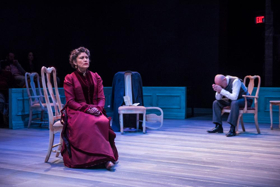Review: A DOLL'S HOUSE, PART 2 at Steppenwolf Theatre Company

A DOLL'S HOUSE, PART 2, now in its world premiere at Steppenwolf under the direction of Robin Witt, explores the gap between society's expectations for the central character Nora and how she perceives herself. Lucas Hnath's sequel to Ibsen's classic, proto-feminist work A DOLL'S HOUSE sees Nora returning through the very door she slammed fifteen years prior. She now must literally face the consequences of her desire to reclaim her identity and her quest to achieve equal rights to the men of 19th century society. In so doing, Hnath reveals that the chasm between Nora's societal/familial obligations and her obligations to herself may never be resolved.
As with some of his other work, Hnath lets the content of A DOLL'S HOUSE, PART 2 dictate the play's form in a fascinating manner. While the play takes place in 1894, the language is delightfully anachronistic and modern. It's often and effectively brash and cheeky, and the characters drop several "F-bombs" throughout the play. The use of modern-day language, which also contrasts with Izumi Inaba's decidedly and delectably period costume designs, also drives home Hnath's exploration of gender roles and the idea of moving forward towards more freedom for women. Though set in the late 19th century, the play also seems to exist very much in the present, which suggests that the work Nora has begun in carving out her own space and career as a woman is yet to be completely realized.
And while Hnath certainly explores that point in A DOLL'S HOUSE, PART 2, that is not to say that Nora comes off blameless in the play. To see Nora return to the house and family she abandoned fifteen years ago is also to see the consequences that those she left behind suffered. Courtney O'Neill's starkly sparse set design also conveys a home that has lost its stereotypically "motherly" touch. The playing space is open, with just a few unfinished wood chairs and side tables for the actors to sit upon and use. Interestingly, too, audiences can opt to sit onstage for the production. Considering the vulnerability of the characters and the precarious situation of the play itself, this adds to the tension.
As portrayed by Sandra Marquez, Nora returns positively ablaze. She's unapologetic in her actions and rationale, and she returns with quite a big favor to ask of her family. Hnath's interpretation of Nora is refreshing and multifaceted, and Marquez takes that to its farthest depths. She makes us see that, for better or worse, Nora feels little remorse for her actions and that she feels entirely justified in returning only in this moment and for her express purpose. And although Marquez's Nora often comes across as selfish, especially in her relentless desire for self-actualization, she also shows us the challenges the character still faces. Above all, Marquez's layered performance demonstrates that while Nora is strong-willed, she's also still craving the intimacy of a relationship in which she can be fully accepted and understood.
Just as Hnath's depiction of Nora is multilayered, so too is that of the other characters in the piece. Nora's husband Torvald (Yasen Peyankov) garners a great deal of sympathy. That's in part because Peyankov's stage presence makes him immensely likable. He has an affable, genuine delivery and energy that provides a contrast to Marquez's charged up energy as Nora. Hnath also uses the dynamic between Nora and Torvald to further underscore that these two characters continue to make assumptions about one another and that their days of miscommunication are not yet over.
As the family's housekeeper Anne Marie, Barbara E. Robertson infuses so much humor into A DOLL'S HOUSE, PART 2. Hnath's play asks many probing questions, but it's also chock full of funny one-liners. Robertson mines those moments for maximum effect.
Of course, Nora not only left behind her husband and Anne Marie, but also her three children. Nora's eldest child, Emmy, makes a brief appearance in the play, and it's a stark, uncomfortable stand-off between Nora and Emmy. Celeste M. Cooper gives a deft, graceful performance as Emmy, who is excited about her recent engagement to a banker. Nora balks in the face of this news, for she sees her former self reflected in Emmy. And while that's an interesting moment, I do think Emmy is underwritten. Nora's desire to leave her children was clearly not one she made lightly, but A DOLL'S HOUSE, PART 2 could yet further explore exactly how that element of Nora's decision has weighed on her.
A DOLL'S HOUSE, PART 2 is a play without easy answers about what it means to move forward in securing equal rights for both genders, and the sacrifices that we must make of others to fully realize ourselves. Hnath does not provide any kind of resolution, but that's what makes the play so remarkable. It simply adds more layers to the questions that we, like Nora herself, must continue to grapple with about what it means to find ourselves and to set forth on the direction that we hope society might also follow.
A DOLL'S HOUSE, PART 2 plays through March 17 in the Downstairs Theatre at Steppenwolf, 1650 North Halsted. Tickets are $20-$99. Visit Steppenwolf.org.
Photo Credit: Michael Brosilow
Add Your Comment
Videos
